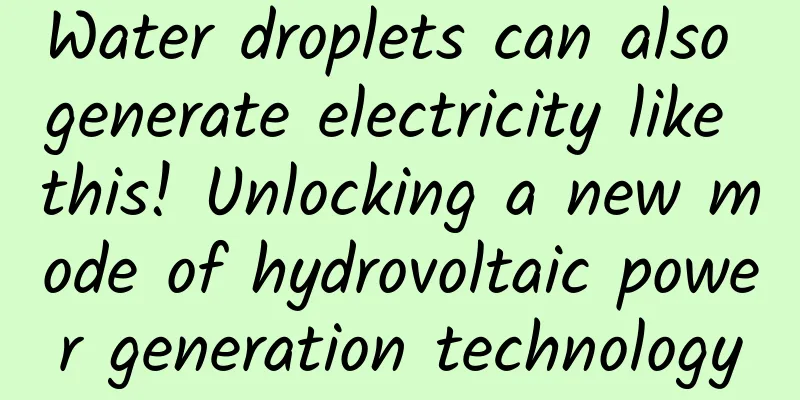Water droplets can also generate electricity like this! Unlocking a new mode of hydrovoltaic power generation technology

|
Produced by: Science Popularization China Author: Shi Chang (PhD in Physical Chemistry) Producer: China Science Expo Editor's note: In order to understand the latest developments in cutting-edge science and technology, the China Science Popularization Frontier Science Project has launched a series of articles titled "Understanding Top Science Journals", which selects outstanding papers from authoritative journals and interprets them in plain language as soon as possible. Let us broaden our scientific horizons and enjoy the fun of science through the window of top journals. The invention of electricity is undoubtedly a profound revolution. From the electric light invented by Edison to the various electronic devices nowadays, the emergence of electricity not only lights up the dark night, but also promotes the rapid development of industry, technology and even the entire society. So do you know where the electricity we use in our daily lives comes from? Glowing light bulb (Photo source: veer photo gallery) Throughout history, people have tried every possible way to obtain electricity from the environment, and power generation technology has become more and more diverse with the advancement of science and technology. Currently, the main sources of electricity are thermal power generation, hydropower generation, photovoltaic power generation, wind power generation, nuclear power generation, solar thermal power generation, etc. Thermal power generation is one of the most important ways of generating electricity at present, and more than half of the world's electricity comes from thermal power generation. Thermal power generation uses the heat energy generated by the combustion of fossil fuels such as coal, oil, and natural gas to generate electricity. The fuel burns in the boiler, heating water to generate steam. The pressure of the steam drives the turbine to rotate, which in turn drives the generator to generate electricity, realizing the conversion of chemical energy-thermal energy-mechanical energy-electrical energy. The principle of hydroelectric power generation is to use the difference in water level. When water flows from high to low, the potential energy is converted into mechanical energy through the turbine, and finally the generator converts the mechanical energy into electrical energy. Hydroelectric power generation is a clean and renewable way to utilize energy. Hydroelectric power plant dam (Photo source: veer photo gallery) Photovoltaic power generation is a power generation method that uses the photoelectric effect of semiconductor materials to directly convert light energy into electrical energy. When sunlight shines on solar panels, photons excite electrons in semiconductors to form current. Photovoltaic power generation has the advantages of being environmentally friendly, noise-free, and sustainable. It is a renewable energy technology that has developed rapidly in recent years. Wind power generation is a way of generating electricity by converting the kinetic energy of wind into electrical energy. The blades of the wind turbine rotate under the action of wind, and the speed of rotation is increased by the speed increaser, thereby driving the generator to generate electricity. Wind power generation is also a clean and renewable energy utilization method, and the resources are widely distributed. Renewable energy generation (Photo source: veer photo gallery) The energy source of nuclear power generation is nuclear fission or nuclear fusion. Currently, commercial nuclear power generation is mainly based on nuclear fission reactions, which can release a large amount of heat energy, which is used to heat water to generate steam and drive steam turbines to generate electricity. Nuclear power generation has the advantages of high energy density and low pollution, but it also has safety risks and technical difficulties. Solar thermal power generation is different from photovoltaic power generation in that it uses solar radiation energy. Solar radiation energy is converted into heat energy through collectors, and then the heat energy is used to heat the medium, thereby driving the steam turbine generator to generate electricity. Solar thermal power generation has the advantages of strong energy storage capacity and stable power generation. Exploring hydroelectric power generation technology in the microscopic world Hydropower generation is an emerging clean energy generation technology in recent years. Different from traditional hydropower generation, hydropower generation utilizes the interaction between functional materials and water droplets, water vapor, atmospheric humidity, etc. in the microscopic world to generate electricity, directly converting the energy in water into electricity. Water drops on leaves (Photo source: veer photo gallery) With the rapid development of nanomaterials, hydrovoltaic power generation technology has become more and more diverse. For example, when graphene materials are taken out of liquid, an electric field will be generated when the graphene materials pass through the water surface, realizing discharge to the outside world. In addition, if water droplets are dropped on one side of a nanomaterial (porous carbon film, porous copper oxide nanowire film, etc.), the water droplets will flow to the other side of the material due to capillary penetration, and electrical energy will be output during the flow of the water droplets. Traditional water droplet power generation equipment will lose its ability to generate electricity as the surface of the material is completely wetted, and the power generation time can only be maintained for a few minutes, which has great limitations in practical applications. So is it possible to break the tradition and extend the working time of water droplet power generation equipment? New water droplet power generation material is developed On July 15, 2024, Chinese scientists published a study on the generation of electricity by upstream proton diffusion in two-dimensional nanochannels in the journal Nature Nanotechnology. This technology breaks the pattern of traditional water droplet power generation, in which the direction of ion movement is consistent with the direction of water flow, and improves the efficiency and duration of water droplet power generation. The research results were published in the journal Nature Nanotechnology (Image source: Nature Nanotechnology magazine) The researchers used vacuum filtration technology to filter the mixed solution of MXene (Ti3C2Tx) and PVA (polyvinyl alcohol), and placed the filtrate in the air to dry, and finally obtained a MXene/PVA composite film (MPCF) . The composite film and the electrode together form a water droplet power generation device. Why is this film so magical? MXene is an emerging two-dimensional nanomaterial composed of transition metals (titanium, vanadium, zirconium, etc.) and non-metallic elements (carbon, nitrogen). It has a layered three-dimensional structure with stacked sheets, similar to graphene. MXene has excellent electrical conductivity and is widely used in sensors, electromagnetic shielding and other fields. PVA is a commonly used high molecular polymer, and its Chinese name is polyvinyl alcohol, which is usually used as an adhesive and wrapping agent. The woodworking glue and solid glue sticks we use in our daily lives contain a large amount of polyvinyl alcohol. a. Schematic diagram of the working principle and channel structure of the MPCF device; b. High-angle annular dark field scanning electron microscope image; c. Graph of voltage and current variation over time; d. Performance comparison of power generation device; ef. Graph of the relationship between water droplet position and power generation voltage. (Image source: Reference 1) To reveal the role of MXene/PVA composite film in water droplet power generation, the researchers characterized its structure. The results showed that the MXene nanosheets in the composite film were wrapped by PVA and stacked into a well-arranged layered nanostructure. There were some channels in the layered nanostructure, which provided a path for the movement of water droplets and ions. In addition, the nanochannels of the composite membrane contain a large number of oxygen-containing functional groups (specific atoms or atomic groups present in organic molecules that determine the chemical properties of organic matter). The oxygen-containing functional groups can react with water to generate a large number of protons, which play an important role in the process of water droplet power generation. How does MXene/PVA composite film generate electricity? The researchers inserted two platinum electrodes on the left and right sides of the composite membrane to form a water droplet power generation device model based on the MXene/PVA composite membrane, and used molecular dynamics simulation methods to reveal the interaction between water droplets and the composite membrane and the principle of power generation. When a water droplet falls on the connection between the composite membrane and the left electrode, due to capillary osmosis, the water droplet enters the pores inside the composite membrane and forms a "water flow" from left to right. Water molecules in the internal channel of the composite membrane react with oxygen-containing functional groups to generate protons, resulting in an increase in the proton concentration in the channel, forming a proton concentration difference with the water droplets. This concentration difference drives the protons to move to the low-concentration water droplets upstream, thereby gathering a large number of protons at the left electrode, causing the potential of the left electrode to be higher than that of the right. When the two electrodes are connected by a wire, electrons are conducted from the right electrode to the left electrode, generating current. a. Schematic diagram of MPCF power generation principle; b. Molecular dynamics simulation process; c. Proton number change over time; d. Distribution of water and proton concentration in MPCF; e. Change of proton concentration over time. (Image source: Reference 1) The experimental test results show that dropping 5 microliters of water on the composite membrane can generate a voltage of more than 400 millivolts, and after 330 minutes, the voltage can still be maintained above 300 millivolts. When the volume of the water droplet increases to 10 microliters, 20 microliters, and 30 microliters, the power generation time can be extended to 500 minutes, 630 minutes, and 830 minutes, respectively. Application prospects The MXene/PVA composite film has the advantages of thin thickness and stable structure. The volume of the integrated micro-power generation equipment is less than 0.1 cubic centimeter, which is of great value in miniaturized, self-powered systems. Sports bracelet (Photo source: veer photo gallery) The water drop power generation device containing the composite film can be integrated into clothing. After the user exercises for 20 minutes, the water absorbed by the power generation device can generate a voltage of about 350 millivolts and a current of about 2 microamperes, which can last for 20 minutes. When using human sweat (containing sodium chloride) to generate electricity, the power supply time of the water drop power generation device can be extended to 30 days. Imagine if you wore a bracelet powered by water droplets, you would no longer have to worry about battery life. Even when you are not exercising, you can charge it by dropping a few drops of water or absorbing moisture from the environment. This not only provides convenience for our lives but also achieves the goal of saving electricity. Conclusion With the advancement and innovation of science and technology, mankind is gradually realizing the transformation from natural resources to sustainable energy. Let us go hand in hand, keep moving forward in exploration and practice, and witness the glorious moment when hydroelectric power generation technology goes from dream to reality. References: 1.Xia, H., Zhou, W., Qu, X. et al. Electricity generated by upstream proton diffusion in two-dimensional nanochannels[J]. Nat. Nanotechnol, 2024. 2.Xu, W., Zheng, H., Liu, Y. et al. A droplet-based electricity generator with high instantaneous power density[J]. Nature, 2020. 3. Feng Sijia, Li Lianhui, Liu Mengyuan, et al. Braidable flexible fiber-shaped hydrovoltaic nanogenerator[J]. Science China: Technological Sciences, 2022. 4. Zhang Jijun, Zhang Pu. Hydrovoltaic induction power generation technology and its application scheme on navigation marks[J]. China Maritime Affairs, 2020. |
Recommend
How to find the Tik Tok ID? Where is my Tik Tok ID?
Open the software in our mobile phone and log in ...
Mobile network connection processing strategy under weak network
1. Background How to measure and simulate "w...
How long will Apple's decline continue? Can iPhone 7 turn the tide?
How long will Apple's decline continue? Can i...
How to successfully create a "viral" message
Introduction: As a marketer, understanding consum...
The 40 most popular Android open source projects on GitHub source code packaging
Source code size: 23MB Source code category: Dome...
Why didn’t QQ die out like MSN under the strong impact of WeChat?
QQ is the social platform with the largest number...
Can human tissues or organs completely regenerate, thus achieving immortality?
Produced by: Science Popularization China Author:...
Reshuffle in the mobile phone industry? Apple stands firm, Honor rises, Xiaomi declines
The landscape of China's mobile phone market ...
What kind of smartphone do we need in 2015?
January 29 (Reporter Zhang Zhichang) At the fourt...
How to build a data operation system for a P2P platform?
It has been more than three years since I started...
If a tool app wants to transform, what should the operators do?
Meitu was cashed out by early-stage investment in...
The Spring Festival Gala sponsorship of TikTok and Huoshan Video has been withdrawn. Will short videos follow in the footsteps of hip-hop?
What is coming will come, whether it is during th...
The secret behind the rapid growth of Airbnb and YouTube users...
Why is YouTube the fastest growing company in Sil...
Qidong SEO training: If you want to do online promotion, website structure is very important
With the development of the Internet era, everyon...
Smart TV ecosystem has diversified gameplay: LeTV gradually becomes the industry benchmark
The battle for the "smart TV ecosystem"...









![[Health Preservation in the 24 Solar Terms] Health Preservation Soup in Cough Season and Heavy Snow Season](/upload/images/67f20e505f2b4.webp)